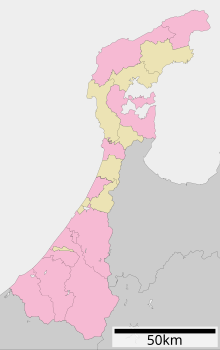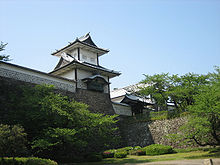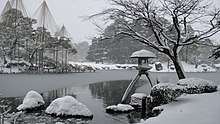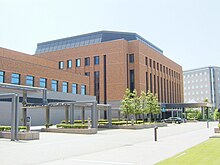Ishikawa Prefecture
Ishikawa Prefecture 石川県 | |||
|---|---|---|---|
| Japanese transcription(s) | |||
| • Japanese | 石川県 | ||
| • Rōmaji | Ishikawa-ken | ||
| |||
 | |||
| Country | Japan | ||
| Region | Chūbu Hokuriku | ||
| Island | Honshu | ||
| Capital | Kanazawa | ||
| Government | |||
| • Governor | Masanori Tanimoto | ||
| Area | |||
| • Total | 4,185.22 km2 (1,615.92 sq mi) | ||
| Area rank | 35th | ||
| Population (February 1, 2011) | |||
| • Total | 1,168,929 | ||
| • Rank | 34th | ||
| • Density | 279.30/km2 (723.4/sq mi) | ||
| ISO 3166 code | JP-17 | ||
| Districts | 5 | ||
| Municipalities | 19 | ||
| Flower | Black lily (Fritillaria camtschatcensis) | ||
| Tree | Hiba (Thujopsis dolabrata) | ||
| Bird | Golden eagle (Aquila chrysaetos) | ||
| Website | [1] | ||
Ishikawa Prefecture (石川県 Ishikawa-ken) is a prefecture of Japan located in the Chūbu region on Honshu island.[1] The capital is Kanazawa.[2]
Contents
History[edit]
Ishikawa was formed in 1872 from the merger of Kaga Province and the smaller Noto Province.[3]
Geography[edit]
Ishikawa is on the Sea of Japan coast. The northern part of the prefecture consists of the narrow Noto Peninsula, while the southern part is wider and consists mostly of mountains with the prefecture's chief city, Kanazawa, located in the coastal plain. The prefecture also has some islands, including Notojima, Mitsukejima, Hegurajima.
As of 1 April 2012[update], 13% of the total land area of the prefecture was designated as Natural Parks, namely the Hakusan National Park; Echizen-Kaga Kaigan and Noto Hantō Quasi-National Parks; and five Prefectural Natural Parks.[4]
Cities[edit]
Eleven cities are located in Ishikawa Prefecture:
Towns[edit]
These are the towns in each district:
|
|
|
Mergers[edit]
Economy[edit]
Ishikawa's industry is dominated by the textile industry, particularly artificial fabrics, and the machine industry, particularly construction machinery.
Demographics[edit]
Ishikawa Prefecture has an area of 4,185 km² and, as of 1 April 2011[update], it has a population of 1,166,643 persons.[citation needed]
| Data | Unit | Statistics |
|---|---|---|
| Area | km² | 4,185 |
| Population | Persons | 1,166,643 |
| Population density | Persons per km² | 278.72 |
| Number of households | Households | 441,980 |
| Income per person | Thousand yen | 2,707 |
| Power consumed | Kwh per household | 6,446 |
| Number of doctors | Physicians per
100,000 people |
249 |
List of Governors of Ishikawa Prefecture[edit]
- Wakio Shibano (柴野和喜夫) (12 April 1947 to 23 February 1955)
- Jūjitsu Taya (田谷充実) (24 February 1955 to 19 February 1963)
- Yōichi Nakanishi (中西陽一) (23 February 1963 to 2 February 1994)
- Masanori Tanimoto (谷本正憲) (29 March 1994 to present)
Culture[edit]

The area is noted for arts and crafts and other cultural traditions:
- The art of Noh was introduced to the area during the rule of the fifth Maeda lord Tsunanori and was refined into the style of Kaga hosho.
- The tea ceremony was introduced in 1666 when Maeda Toshitsune invited Senbiki Soshitsu of Urasenke to Kanazawa.
- Kutani ware (Kutani yaki) is a bright colored glaze like Chinese porcelain.
- Ohi teaware (Ōhi yaki) is a pottery with a style unique to Kanazawa.
- Nyotaimori or naked sushi is said to have originated in Ishikawa Prefecture.
- Kaga silk (Kaga yūzen) is made with complicated silk print technique with an intentional rough look (wabi-sabi).
- Kanazawa lacquerware (Kanazawa shikki) is high quality lacquerware traditionally decorated with gold dust.
- Kanazawa gold leaf (Kanazawa haku) is produced with a technique of beating gold into wafer-thin sheets.
- Kaga mizuhiki is ribbon-like decoration made from glued Japanese paper (washi).
- Kaga inlay crafts (Kaga zōgan) are made with a combination of thin flat and thread metal inlays.
- Gojinjo Daiko is a Japanese drum, a Wajima city cultural heritage (since 1961) as well as an Ishikawa Prefecture intangible cultural heritage (since 1963).
- Abare Festival is reputed the most 'fierce' festivals of Noto, Ishikawa.
Tourism[edit]

The most popular destination in Ishikawa is Kanazawa. Tourists can get to Ishikawa by plane via either the Komatsu or Noto airports. Popular sites include:
- 1000 Rice Fields
- 21st Century Museum of Contemporary Art, Kanazawa
- Chirihama Driveway
- Higashi-chaya district in Kanazawa
- Ishikawa Prefectural Museum of Art
- Kaga hot-springs district
- Kenroku-en
- Mount Haku
- Shibayama Lagoon
- Wajima Morning Market
Prefectural symbols[edit]
- Fritillaria camschatcensis (flower)
- Golden eagle (bird)
- Thujopsis dolabrata (tree)
Notable people[edit]
- Kitaro Nishida, philosopher, founder of the Kyoto School of philosophy, from Kahoku.
- Kyōka Izumi, author of novels, short stories, and kabuki plays, from Kanazawa.
- Murō Saisei, poet and novelist in modern Japanese literature from Kanazawa.
- Shūsei Tokuda, author from Kanazawa.(Izumi, Muro, and Tokuda are known as the Three Famous Literary Persons in Ishikawa[5])
- Takeshi Kaga, an actor in Japan who is probably best known internationally for his portrayal of Chairman Kaga in the Japanese television show Iron Chef produced by Fuji TV, is from Ishikawa.
- Hideki Matsui, a former Yomiuri Giants and New York Yankees, was born and raised in Neagari Town (now Nomi City), Ishikawa. He gained fame as a baseball player while attending high school in Kanazawa.
- Daisuke Nakata, a trampolinist who has competed in the Olympics in the past, is from Ishikawa.
Universities[edit]
Ishikawa has a number of universities:
- Kanazawa University
- Hokuriku University a small liberal arts university with a School of Pharmacy and a School of Future Learning that gives instruction in Business, Economics, and Foreign Language (Chinese and English).
- Ishikawa Prefectural Nursing University
- Ishikawa Prefectural University
- Japan Advanced Institute of Science and Technology
- Kanazawa College of Art
- Kanazawa Gakuin University
- Kanazawa Institute of Technology
- Kanazawa Medical University
- Kanazawa Seiryo University
- Kinjo Junior College
Transport[edit]
Rail[edit]
- JR West
- Hokuriku Railway (Hokutetsu)
- Asanokawa Line
- Ishikawa Line
- Noto Railway Nanao Line
- IR Ishikawa Railway Line
Road[edit]
Expressways and toll roads[edit]
- Hakusan Super Forest Road
- Hokuriku Expressway
- Noetsu (Noto-Etsuchu) Expressway
- Noto Toll Road
National highways[edit]
- National Route 8
- National Route 157 (Kanazawa - Hakusan - Katsuyama - Motosu - Gifu)
- National Route 159
- National Route 160
- National Route 249
- National Route 304
- National Route 305
- National Route 359
- National Route 360 (Toyama - Hida - Shirakawa - Komatsu)
- National Route 364
- National Route 365
- National Route 415
- National Route 416
- National Route 470 (Wajima - Himi - Takaoka - Oyabe - Tonami)
- National Route 471
Ports[edit]
- Kanazawa Port (International container hub port)
- Nanao Port
Airports[edit]
Regional policies[edit]
Politics[edit]
The current governor of Ishikawa is Masanori Tanimoto who was first elected in 1994 and has been reelected for a sixth term in the gubernatorial election in March 2014.[6] Tanimoto is currently one of two governors who are in their sixth term nationwide, the other being Masaru Hashimoto of Ibaraki. Tanimoto is only the fourth governor of Ishikawa since 1947 when prefectural governors became elected offices, as predecessor Yōichi Nakanishi had held the governorship even longer than Tanimoto, winning his first election in 1963 and then serving eight consecutive terms until his death in 1994.
The prefectural assembly of Ishikawa has 43 members and is elected in unified local elections (last round: 2011) in 15 SNTV electoral districts – six single-member, five two-member, one three-member, two four-member districts and the Kanazawa City district that elects 16 members. As of February 26, 2014, the LDP prefectural assembly caucus has 25 members and no other group has more than four members.[7]
In the National Diet, Ishikawa is represented by three directly elected members of the House of Representatives and two (one per election) of the House of Councillors. Additional members from the prefecture may be elected in the proportional representation segments of both houses: the Hokuriku-Shin'etsu proportional representation block in the lower house, the proportional election to the upper house is nationwide. After the Diet elections of 2010, 2012 and 2013, the five directly elected members from Ishikawa districts are all Liberal Democrats, namely:
- in the House of Representatives
- for the 1st district that covers Kanazawa City: Hiroshi Hase, LDP, 5th term,
- for the 2nd district that consists of Southern parts of Ishikawa and had been the district of former LDP president Yoshirō Mori until 2012: Hajime Sasaki, LDP, 1st term,
- for the 3rd district in the North: Shigeo Kitamura, LDP, 3rd term,
- in the House of Councillors
- in the class of 2010 (term ends 2016): Naoki Okada, LDP, 2nd term, and
- in the class of 2013 (term ends 2019): Shūji Yamada, LDP, 1st term who was able to defeat Democratic incumbent and former defense minister Yasuo Ichikawa by a huge margin in 2013.
Notes[edit]
- ^ Nussbaum, Louis-Frédéric. (2005). "Chūbu" in Japan Encyclopedia, p. 126, p. 126, at Google Books.
- ^ Nussbaum, "Kanazawa" in p. 467, p. 467, at Google Books.
- ^ Nussbaum, "Provinces and prefectures" in p. 780, p. 780, at Google Books.
- ^ "General overview of area figures for Natural Parks by prefecture" (PDF). Ministry of the Environment. Archived (PDF) from the original on April 21, 2012. Retrieved July 2, 2012.
- ^ "Archived copy" (PDF). Archived (PDF) from the original on April 24, 2018. Retrieved February 6, 2018.CS1 maint: Archived copy as title (link) The Forth High School Memorial Museum of Cultural Exchange, Ishikawa
- ^ 47 News/Kyōdō Tsūshin, March 16, 2014: 石川県知事選、谷本氏6選果たす 2新人退け全国最多に並ぶ Archived March 16, 2014, at the Wayback Machine
- ^ Ishikawa Prefectural Assembly: members by caucus Archived March 16, 2014, at the Wayback Machine (in Japanese)
References[edit]
- Nussbaum, Louis-Frédéric and Käthe Roth. (2005). Japan encyclopedia. Cambridge: Harvard University Press. ISBN 978-0-674-01753-5; OCLC 58053128
External links[edit]
| Wikimedia Commons has media related to Ishikawa Prefecture. |
 Ishikawa travel guide from Wikivoyage
Ishikawa travel guide from Wikivoyage- Official website
- Cultural assets of Ishikawa







